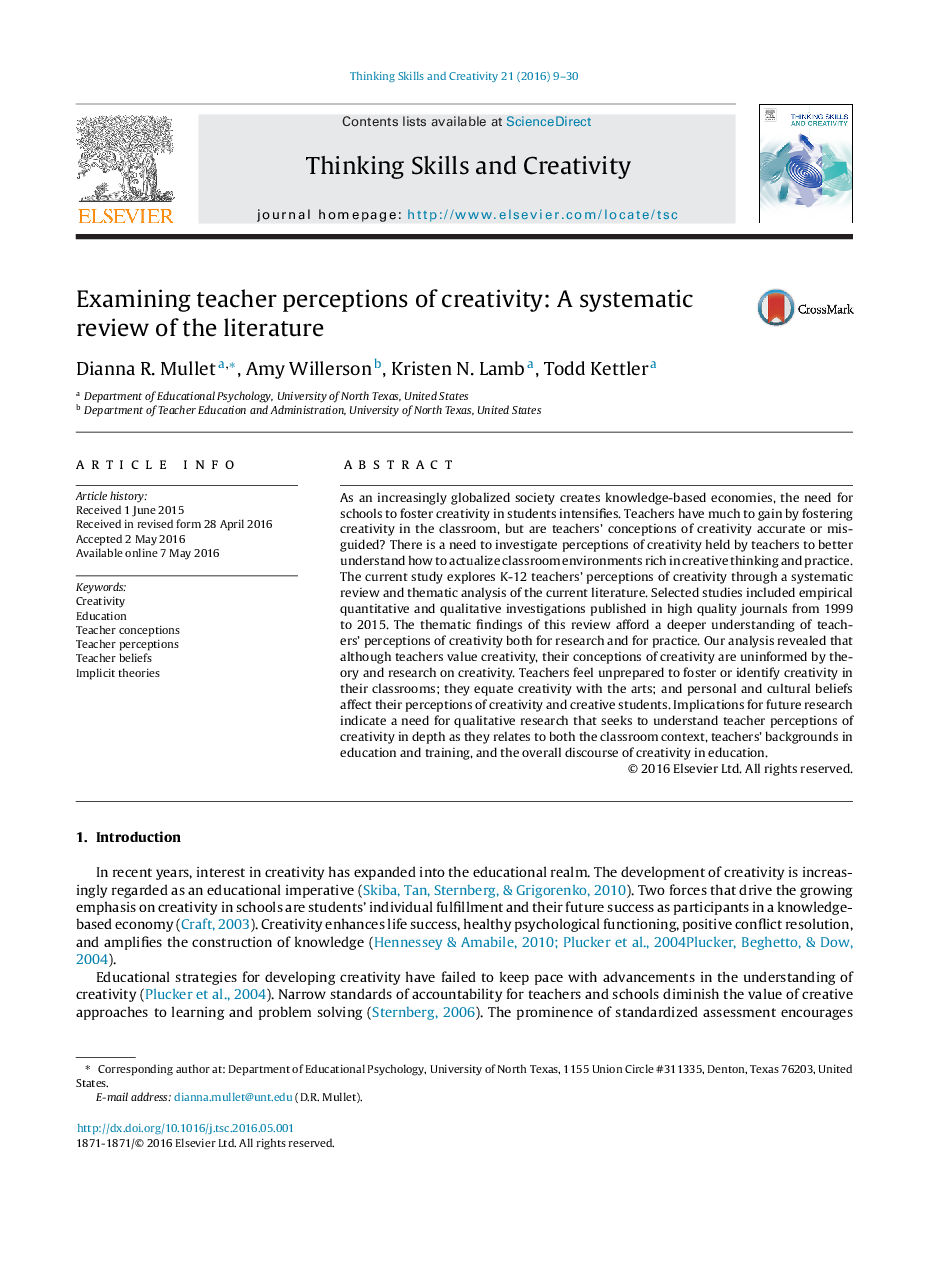| کد مقاله | کد نشریه | سال انتشار | مقاله انگلیسی | نسخه تمام متن |
|---|---|---|---|---|
| 375507 | 622800 | 2016 | 22 صفحه PDF | دانلود رایگان |
• Researchers and teachers have different conceptions of creativity and creative behaviors in students. Teachers’ conceptions of creativity were generally incomplete. Many teachers believed that all students had some degree of creative potential and that creativity could be developed in everyone. Other teachers subscribed to a deficit model, viewing creativity as an innate quality of some students but not others.
• Teachers often defined creativity in terms of intellectual ability or divergent thinking. Less often, teachers defined creativity in terms of inventiveness, originality, curiosity, flexibility, autonomy, or the ability to make connections. Training had a substantial effect on teachers’ definitions of creativity. Teachers’ conceptualizations became more mature and closer to researchers’ definitions after participation in training or professional development.
• Teachers frequently interpreted many scholar-designated creative behaviors (e.g. impulsivity or stubbornness) as misbehaviors, especially when those behaviors were less classroom-desirable. Teachers frequently perceived creative behaviors and characteristics as those that reflect social conformity, intellectual ability, artistic ability, maturity imagination, and curiosity. Creativity scholars, on the other hand, tended to nominate behaviors that reflect openness, risk-taking, critical thinking, flexibility, sensitivity, questioning of authority, and nonconformity.
• Teachers’ perceptions of creativity may be related to the extent of a teacher’s experience. Although some research indicated that less experienced teachers seem to have a more balanced, sophisticated view of creativity than teachers with more experience, other research suggested that perceptions of creativity are similar among pre-service and in-service teachers. This question essentially remains unanswered and warrants future research.
As an increasingly globalized society creates knowledge-based economies, the need for schools to foster creativity in students intensifies. Teachers have much to gain by fostering creativity in the classroom, but are teachers’ conceptions of creativity accurate or misguided? There is a need to investigate perceptions of creativity held by teachers to better understand how to actualize classroom environments rich in creative thinking and practice. The current study explores K-12 teachers’ perceptions of creativity through a systematic review and thematic analysis of the current literature. Selected studies included empirical quantitative and qualitative investigations published in high quality journals from 1999 to 2015. The thematic findings of this review afford a deeper understanding of teachers’ perceptions of creativity both for research and for practice. Our analysis revealed that although teachers value creativity, their conceptions of creativity are uninformed by theory and research on creativity. Teachers feel unprepared to foster or identify creativity in their classrooms; they equate creativity with the arts; and personal and cultural beliefs affect their perceptions of creativity and creative students. Implications for future research indicate a need for qualitative research that seeks to understand teacher perceptions of creativity in depth as they relates to both the classroom context, teachers’ backgrounds in education and training, and the overall discourse of creativity in education.
Journal: Thinking Skills and Creativity - Volume 21, September 2016, Pages 9–30
